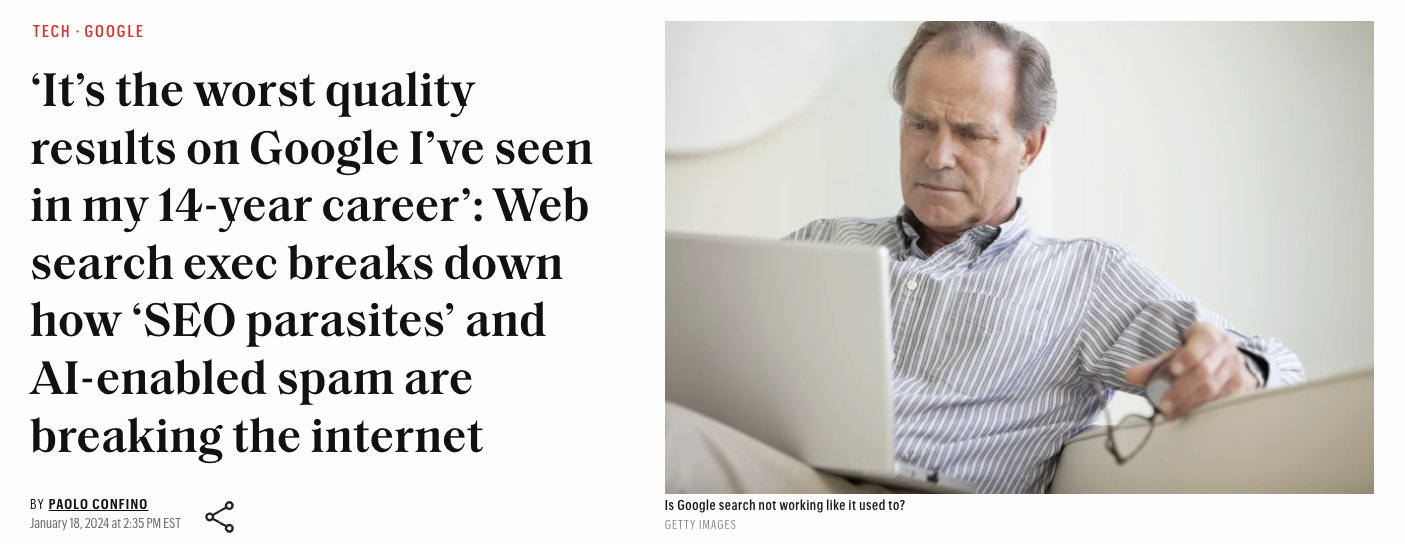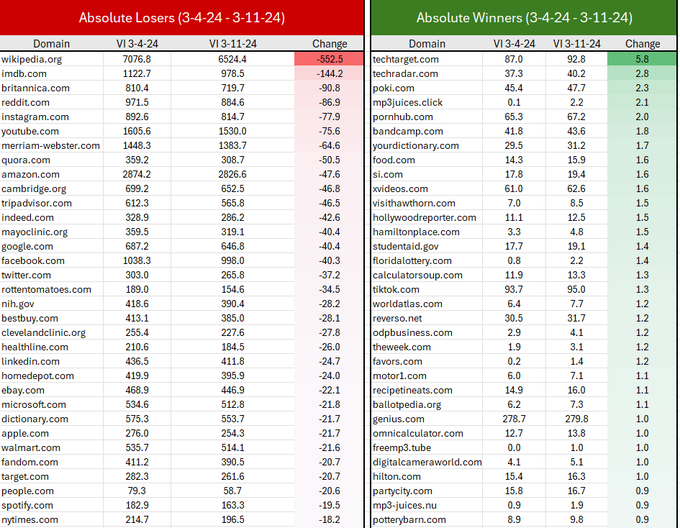The world of search is undergoing a seismic shift, and AI clearly seems to be the catalyst for this transformation. Google's March 2024 Core Update, which includes both a Core and a Spam update, has sent shockwaves throughout the SEO and publishing industries.
Google generates nearly 40% of publishers’ traffic, accounting for the largest share of their “referrals.” Following this update, many publishers have reported a negative impact, with the entire network crumbling for some publishers.
The future of search is upon us.
Google claims its latest algorithm update will reduce low-quality, unoriginal, and unhelpful content in its search results by 40%.
Over the last several months, Google has received more negative press about its results than ever before, with some claiming that the proliferation of fluffy AI-generated junk in the results has made Google unusable.

The new core update is going to be a game-changer, and Google thinks so, too. The search giant has been quite forthcoming with the media and announcing the update through various channels, including a detailed post on its primary search blog, updates to its spam policy documentation, and numerous employee posts on official social media accounts.
Google has made itself clear:
Using automation to create content at scale without human oversight will be seen as a policy violation. However, AI-generated content that follows quality guidelines and adds value for its users will remain acceptable.
The company's CEO, Sundar Pichai, has stated that SGE (Search Generative Experience) would become the future of search and the next significant evolution of the search engine. This shift towards an AI-powered search experience is not surprising, given that Larry Page, co-founder of Google, envisioned AI as the ultimate version of Google back in 2000.
This is both a challenge and an opportunity for media publishers looking to compete and monetize organic traffic.
Publishers committed to generating quality content will succeed while those willing to leverage the power of AI tools are bound to develop a competitive edge. We are here to show you why publishers must switch to video, how to do it, and particularly the role article-to-video generators will play in the future of the publishing world.
Overview of Google March 2024 Core Update
The Core Update aims to enhance the quality of content that appears in search results by prioritizing content that is genuinely useful to users over content that is created solely for attracting clicks or manipulating rankings.
The Spam Update targets sites engaging in spammy practices that violate Google's Webmaster Guidelines, such as keyword stuffing, buying links, and using expired domains to manipulate rankings. It introduces three new spam policies focusing on Expired Domain Abuse, Scaled Content Abuse, and other manipulative practices.
Here are the key highlights:
- Launched on March 5, 2024, the full roll-out will take up to 4 weeks to come into effect
- The impact will be global, including all content types and languages
- Not a penalty on the existing ranking but a way to promote high-quality, helpful content
- Aims to reduce low-quality, unoriginal content in search results by 40%
- Will affect Google Discover, featured snippets, and other features
- Recovery will require improvements based on Google's advice
- Periodic refreshes may occur without communication
Here is Google's post on X:
Today we announced the March 2024 core update & new spam policies that, in combination, are designed to show less content made to attract clicks and more content that people find useful. Learn more: https://t.co/wQVZ8mExRB
— Google Search Central (@googlesearchc) March 5, 2024
Dissecting the changes
Let's look at two major changes in this update: Scaled Content Abuse and Expired Domain Abuse. Both are tactics that attempt to manipulate search rankings and deteriorate user experience.
Scaled content abuse
Scaled content abuse refers to the practice of producing large amounts of unoriginal content to manipulate search rankings. This doesn't just refer to automated content but includes any content generated primarily for ranking purposes, whether automated, human, or a mix of both.
Google's updated policy takes strict action against this kind of misuse, ensuring a better user experience.
It's no surprise that AI-generated content has steadily scaled the search results as AI tools improved, along with the prompt engineering of SEO and content specialists.
Expired domain abuse
Expired domain abuse, on the other hand, occurs when an expired domain is repurchased and revamped primarily to influence rankings.
For instance, a domain that previously belonged to a medical site might now host low-quality casino-related content, trying to leverage the reputation earned by the previous owners to pop up in search results.
Google's March core update is tightening its hold on such practices, emphasizing the need for high-quality, original, and helpful content.
In our view, this is an odd target to introduce, as expired domains aren't intrinsically linked to low-quality and could have high-quality content. So, the reason for this target seems more correlated than causal.
Following the March core update, any attempt at content abuse will face Google's close oversight and potential action. This reflects the growing importance of ethical content strategies.
As content creators, website owners, SEO professionals - we must realign our priorities, focusing more on enhancing user experience and less on quick-win tactics. There's more to SEO than merely indexing and ranking.
Google's shift in focus is a clear message to all practicing in the field:
Create for humans, not bots.
Impact on Digital Media Publishers
For digital media publishers, Google's March 2024 core update serves as a vital reminder about the importance of maintaining a balance between Search Engine Optimization (SEO) and enhancing the user experience. Focused on proactively penalizing undesirable spammy techniques, the update emphasizes the importance of ethical, quality content. It marks a significant shift in Google's guidelines.
Changes in Search Rankings
One of the most transparent effects of this core algorithm update will be a change in search rankings.
Primarily, this will be a result of Google's increased scrutiny of spam content. Before the update, some websites managed to feature prominently on Google searches through tactics such as content abuse, use of expired domains, or even creating content at scale solely for ranking purposes.
Google's new spam policies have put such practices under close oversight, cracking down on attempts to manipulate ranking signals by such means.
According to Lily Ray, early data of a visibility index from Sistrix shows "the losers are losing MUCH more visibility than the biggest winners are gaining." Take a closer look, and you will see that even the most well-known brands on the internet are affected by the update.
Conversely, this core algorithm update is also an opportunity to improve organic reach and attract quality traffic.
By aligning content creation and SEO strategies with Google's new guidelines, website owners and content creators can aspire to be featured more prominently in search rankings, and for the right reasons.
The key here is to generate 'people-first content'. It's about putting out original, high-quality content that caters to the needs of the user and enhances the user experience.
While the initial fluctuations due to these updates may seem like a challenge, for digital media publishers, this is the beginning of an ongoing journey to improve site reputation and avoid the perils of spam policies.
The update clearly outlines Google's priority: creating a helpful content system that fosters a positive user experience. For media publishers prepared to align with this vision, this is a great opportunity.
Adapting to a New Digital Landscape
Short term (1-3 months):
Conduct a content audit and review if each piece on your website offers real value to your audience. Take down / update outdated content, enhance existing material, and remove any content that serves no purpose other than attempting to manipulate search rankings.
Ask yourself: does your content address the needs and questions of your audience?
Refrain from producing low-value, automated content that is solely designed to manipulate search rankings. This includes both AI-generated and human-written content.
Beyond this, there is not much to do immediately to respond to the update's rollout.
Longer term (3-12 months):
The transition to an AI-powered search landscape will not be without its challenges. Businesses that rely solely on producing text-based content (even with good quality) may eventually see a decline in Google visits as AI-driven answer engines evolve and become more prevalent.
Publishers and SEO professionals will undoubtedly need to take significant measures. While more clarity will emerge as we learn how the new search engine rewards websites, we discuss some future-proof strategies that, in our opinion, are bound to define how future success will be shaped.
Video as a Strategic SEO Opportunity
Future AI-powered search engines will generate answers directly within their search interfaces. As a result, traffic to purely text-based websites is likely to drop significantly. Videos, however, look promising. They present an excellent opportunity to compensate for the lost traffic and stay relevant in the long term:
Consider the following:
Video Has The Highest CTR on Search
A 2024 Click-Through Rates (CTR) analysis of Google search page by element reveals that video assets are among the elements with the highest CTR:
Google SERP Feature
Example
CTR
Snippet

42.9% (1st)
27.4% (2nd)
#1 Organic Result

39.8%
Ad Result

1.2 – 2.1%
Image Result

1.4% – 4.9%
Video Result

2.3% – 6.4%
“People Also Ask” Box

3.0%
Knowledge Panel

1.4%
Publishers can use video as a potent tool to engage a diverse audience, build trust, and ultimately drive revenue. There are enough statistics, trends, and real-world examples that show the power of video. Like text, video assets too can be optimized for the right keyword to attract a specific audience.
Overcoming the Video Deficit
Publishers adopting a video-first strategy in response to Google's March 2024 Core Update must first address the challenge of scaling. Generating high-quality, contextually relevant, and user-engaging content is hard, particularly when it comes to video.
If approached conventionally, it is both expensive and time-consuming.
Fortunately, this can be addressed using services like Aeon, which streamline workflow, accelerate production, and ensure relevance while seamlessly incorporating the publisher's brand identity. This results in a highly engaging video repository that not only enhances user engagement but also aligns with Google's emphasis on providing valuable, people-first content.
Aeon: Streamlining Video Production for Publishers
{% video_player "embed_player" overrideable=False, type='hsvideo2', hide_playlist=True, viral_sharing=False, embed_button=False, autoplay=False, hidden_controls=False, loop=False, muted=False, full_width=False, width='1920', height='1080', player_id='146552596876', style='' %}
The video above, automatically generated from this article, exemplifies the type of content that captivates users and complements the written piece. Aeon empowers publishers to efficiently produce high-quality video content for their entire library, drastically reducing the time and cost of manual video creation.
By integrating compelling, contextually relevant video content into their strategies, digital media publishers can align with Google's focus on user experience and helpfulness while keeping pace with their audience's evolving expectations.
Publishers will need agile workflows and advanced tools to flourish in the ever-changing digital landscape. Fortunately, the technology enabling this is getting better and faster!
Conclusion
Google's March 2024 Core Update serves as another compelling reason among many for digital publishers to prioritize video content and stay ahead of the competition. Video, by its nature, facilitates a clearer and more engaging presentation of quality and relevance than text, providing publishers with an invaluable tool to boost user interaction.
It's a continuous quality improvement journey, but it will build your web presence and enhance audience interaction. So embrace these changes and watch your digital media platform soar to new heights!

